1 of 9
Downloaded 20 times
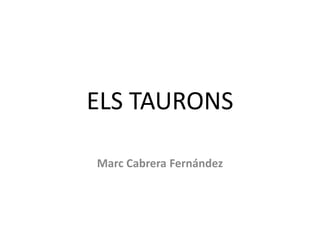

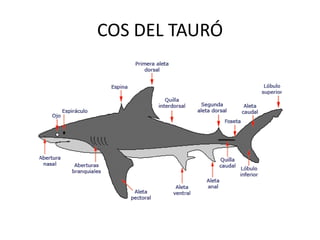


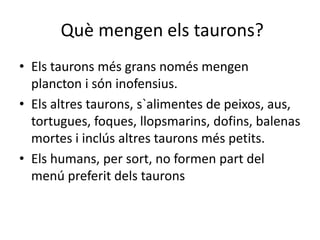
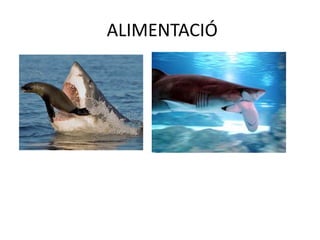

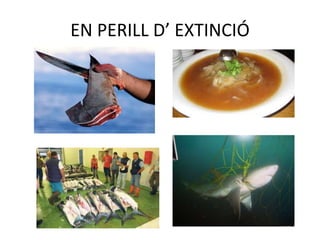
Ad
Recommended
Projecte classe taurons P5B
Projecte classe taurons P5BEscola Mn. Josep Arques
╠²
Escola Mn. Josep Arques: Projecte classe taurons P5B (curs 2017-2018).Els Taurons
Els TauronsEduardo CONNOLLY
╠²
Power point educatiu damunt els taurons, hi ha dues versions m├®s ampliades en aquesta mateixa plana. Podeu descarregar-vos totes les que volgueu, per aix├▓ estan.Els Taurons 3 Ampliat
Els Taurons 3 AmpliatEduardo CONNOLLY
╠²
Una presentaci├│ m├®s ├Āmplia sobre els taurons, pensada perqu├© pugi servir a diferents nivells.Els elefants
Els elefantsmarquibany
╠²
The document is about elephants and contains several sections about different aspects of elephants including how they walk, bathe and play, how babies are born, their weight, descriptions of their skin and trunk, where they live in Asia and Africa, what they eat, and the differences between African and Asian elephants. It includes poems, diagrams, and descriptions in both text and image form.Els taurons
Els tauronsSandra Pina
╠²
The students in the class chose to learn about sharks. They brainstormed what they already knew about sharks and questions they had. They discussed the best ways to research sharks, such as looking at books, websites, and potentially visiting an aquarium. The class then worked together to organize what they learned about sharks' appearance, diet, habitat, behaviors and more. They began learning about different shark species and characteristics.Els taurons
Els tauronsSandra Pina
╠²
The students in the class chose to learn about sharks. They brainstormed what they already knew about sharks and questions they had. They discussed the best ways to research sharks, such as looking at books, websites, and potentially visiting an aquarium. The class then worked together to organize what they learned about sharks' appearance, diet, habitat, behaviors and more. They began learning about different shark species and characteristics.Projecte del conill. curs 2010 11
Projecte del conill. curs 2010 11rosaraset
╠²
The document provides information about rabbits. It describes their physical characteristics such as having 2 eyes, long ears, a short tail, whiskers, and 4 feet with the back feet being longer and stronger. It discusses what rabbits eat, including pellets, carrots, grass, corn, apples, dried bread, and that they need fresh water and branches to gnaw on. It also notes that rabbits live in cages, woods, or burrows and describes the skeleton of a rabbit.Taller de lectura: Mapes conceptuals
Taller de lectura: Mapes conceptualsBeatriu PALAU
╠²
Una manera senzilla de fer mapes conceptuals a partir del modelatge del mestre i compartir-ho amb els companys.Els Cocodrils Modificat
Els Cocodrils ModificatEduardo CONNOLLY
╠²
Cocodrils are large reptiles covered in bony plates on their backs and tails and scales on their sides. They have short legs with webbed digits and powerful jaws and sharp teeth used to catch and hold prey without chewing. Cocodrils live in rivers, lakes, swamps and other freshwater and saltwater habitats in warm countries, preying on various animals and even humans by ambushing them at water's edge. Females lay between 20 to 60 eggs which they bury and guard until hatching.Els tigres
Els tigresmmatarin
╠²
The students in class P-5 B voted on a name for their class and chose "Tigers". They then learned many facts about tigers, such as where they live in Asia, what they eat (meat from animals they hunt), and how they hunt (by waiting in ambush for prey). The students created a project to share what they learned about tigers, including diagrams of their skeleton and parts, descriptions of cubs being born and living with their mother for a few years, and more details about tigers' appearance, behaviors, and habitat.Projecte Els peixos P-4
Projecte Els peixos P-4acalvis
╠²
The students in the class studied fish as their class project. They researched fish, created an index of what they wanted to learn, organized the information on a classroom mural, and experimented. They learned about how fish breathe, move, are born, eat and digest food, float, and more. They decorated their classroom door and set up an aquarium as part of their project.Power dinosaures p5b
Power dinosaures p5bescolanovacervello
╠²
The students in the class voted to name their class "The Dinosaurs Class". They received a pet dinosaur named Titi to learn more about dinosaurs. The students discussed what they knew about the era when dinosaurs lived and how the landscape was different than today. They learned the period when dinosaurs lived was called the Mesozoic Era, which was divided into the Triassic, Jurassic and Cretaceous periods. During this time, the continents were joined together and life was dominated by large reptiles such as dinosaurs.Oficis i einesMontse Conesa Borrull
╠²
El documento lista diferentes oficios como mec├Īnico, escombriero, fornero y lampista.Power conills
Power conillsGarrido1
╠²
The document discusses several facts about rabbits:
1) Rabbits eat plants like grass, lettuce, leaves and carrots. They live in fields and forests.
2) Baby rabbits are called kittens. They are born blind and hairless from their mother's womb. The mother nurses the kittens once a night.
3) Rabbits can start reproducing from 3-6 months after birth. Females can have litters of 10-12 kittens every 31 days, so the rabbit population can grow quickly. Els Cocodrils
Els CocodrilsEduardo CONNOLLY
╠²
Cocodrils are large reptiles that live in warm regions like Africa, Australia, Asia, and South and Central America. They live in rivers, lakes, swamps, and other freshwater or saltwater environments. Cocodrils are carnivorous and will eat almost any animal, including humans. They hunt by hiding in water and ambushing animals when they come to drink, quickly drowning their prey before eating it. Cocodrils lay between 20 to 60 eggs which they bury and the mothers protect until the young hatch.PROJECTE 2n B: Els r├©ptils
PROJECTE 2n B: Els r├©ptilsinicialroc
╠²
Reptiles are vertebrate animals covered in hard scales. They are oviparous, meaning they hatch from eggs. The temperature during egg incubation determines the sex of the hatchling. Reptiles are cold-blooded and need sunlight to warm their bodies. Most are carnivorous, except turtles which are herbivorous. There are over 8,000 reptile species worldwide belonging to four main types: crocodiles, turtles, lizards, and snakes.Els Taurons Ampliat 2
Els Taurons Ampliat 2Eduardo CONNOLLY
╠²
el mateix power point d'abans amb unes diapositives m├®s en relaci├│ a formes de reporducci├│. adre├¦at a nins de prim├ĀriaMore Related Content
What's hot (20)
Els taurons
Els tauronsSandra Pina
╠²
The students in the class chose to learn about sharks. They brainstormed what they already knew about sharks and questions they had. They discussed the best ways to research sharks, such as looking at books, websites, and potentially visiting an aquarium. The class then worked together to organize what they learned about sharks' appearance, diet, habitat, behaviors and more. They began learning about different shark species and characteristics.Els taurons
Els tauronsSandra Pina
╠²
The students in the class chose to learn about sharks. They brainstormed what they already knew about sharks and questions they had. They discussed the best ways to research sharks, such as looking at books, websites, and potentially visiting an aquarium. The class then worked together to organize what they learned about sharks' appearance, diet, habitat, behaviors and more. They began learning about different shark species and characteristics.Projecte del conill. curs 2010 11
Projecte del conill. curs 2010 11rosaraset
╠²
The document provides information about rabbits. It describes their physical characteristics such as having 2 eyes, long ears, a short tail, whiskers, and 4 feet with the back feet being longer and stronger. It discusses what rabbits eat, including pellets, carrots, grass, corn, apples, dried bread, and that they need fresh water and branches to gnaw on. It also notes that rabbits live in cages, woods, or burrows and describes the skeleton of a rabbit.Taller de lectura: Mapes conceptuals
Taller de lectura: Mapes conceptualsBeatriu PALAU
╠²
Una manera senzilla de fer mapes conceptuals a partir del modelatge del mestre i compartir-ho amb els companys.Els Cocodrils Modificat
Els Cocodrils ModificatEduardo CONNOLLY
╠²
Cocodrils are large reptiles covered in bony plates on their backs and tails and scales on their sides. They have short legs with webbed digits and powerful jaws and sharp teeth used to catch and hold prey without chewing. Cocodrils live in rivers, lakes, swamps and other freshwater and saltwater habitats in warm countries, preying on various animals and even humans by ambushing them at water's edge. Females lay between 20 to 60 eggs which they bury and guard until hatching.Els tigres
Els tigresmmatarin
╠²
The students in class P-5 B voted on a name for their class and chose "Tigers". They then learned many facts about tigers, such as where they live in Asia, what they eat (meat from animals they hunt), and how they hunt (by waiting in ambush for prey). The students created a project to share what they learned about tigers, including diagrams of their skeleton and parts, descriptions of cubs being born and living with their mother for a few years, and more details about tigers' appearance, behaviors, and habitat.Projecte Els peixos P-4
Projecte Els peixos P-4acalvis
╠²
The students in the class studied fish as their class project. They researched fish, created an index of what they wanted to learn, organized the information on a classroom mural, and experimented. They learned about how fish breathe, move, are born, eat and digest food, float, and more. They decorated their classroom door and set up an aquarium as part of their project.Power dinosaures p5b
Power dinosaures p5bescolanovacervello
╠²
The students in the class voted to name their class "The Dinosaurs Class". They received a pet dinosaur named Titi to learn more about dinosaurs. The students discussed what they knew about the era when dinosaurs lived and how the landscape was different than today. They learned the period when dinosaurs lived was called the Mesozoic Era, which was divided into the Triassic, Jurassic and Cretaceous periods. During this time, the continents were joined together and life was dominated by large reptiles such as dinosaurs.Oficis i einesMontse Conesa Borrull
╠²
El documento lista diferentes oficios como mec├Īnico, escombriero, fornero y lampista.Power conills
Power conillsGarrido1
╠²
The document discusses several facts about rabbits:
1) Rabbits eat plants like grass, lettuce, leaves and carrots. They live in fields and forests.
2) Baby rabbits are called kittens. They are born blind and hairless from their mother's womb. The mother nurses the kittens once a night.
3) Rabbits can start reproducing from 3-6 months after birth. Females can have litters of 10-12 kittens every 31 days, so the rabbit population can grow quickly. Els Cocodrils
Els CocodrilsEduardo CONNOLLY
╠²
Cocodrils are large reptiles that live in warm regions like Africa, Australia, Asia, and South and Central America. They live in rivers, lakes, swamps, and other freshwater or saltwater environments. Cocodrils are carnivorous and will eat almost any animal, including humans. They hunt by hiding in water and ambushing animals when they come to drink, quickly drowning their prey before eating it. Cocodrils lay between 20 to 60 eggs which they bury and the mothers protect until the young hatch.PROJECTE 2n B: Els r├©ptils
PROJECTE 2n B: Els r├©ptilsinicialroc
╠²
Reptiles are vertebrate animals covered in hard scales. They are oviparous, meaning they hatch from eggs. The temperature during egg incubation determines the sex of the hatchling. Reptiles are cold-blooded and need sunlight to warm their bodies. Most are carnivorous, except turtles which are herbivorous. There are over 8,000 reptile species worldwide belonging to four main types: crocodiles, turtles, lizards, and snakes.Similar to Taurons (20)
Els Taurons Ampliat 2
Els Taurons Ampliat 2Eduardo CONNOLLY
╠²
el mateix power point d'abans amb unes diapositives m├®s en relaci├│ a formes de reporducci├│. adre├¦at a nins de prim├ĀriaEls taurons
Els tauronsescolabrasilfestes
╠²
Power point elaborat pels alumnes de cinqu├© curs de l'Escola Brasil treballant el tema dels animals vertebrats.
Curs 2014-15Treball el taur├│
Treball el taur├│ElFrigoletPorqueres
╠²
Presentaci├│ en Power Point sobre el taur├│ feta per l'alumne Joan Tejero de 3r.Peixos de les balears
Peixos de les balearsBiologia i Geologia
╠²
Presentaci├│ realitzada per l'alumnat de TCE de l'IES Xarc.Els taurons.doc
Els taurons.docescolabrasilfestes
╠²
Power point elaborat pels alumnes de cinqu├© curs de l'Escola Brasil treballant el tema dels animals vertebrats.
Curs 2014-15Ad
More from CarmeCL (17)
Pantera negraCarmeCL
╠²
La pantera negra es una variaci├│n de los grandes felinos que vive en climas c├Īlidos de ├üfrica y Asia, habitando bosques, sabanas y selvas. Es un mam├Łfero solitario excepto para reproducirse, cazando presas como ciervos y monos para alimentarse. Siendo una especie en peligro de extinci├│n, sus mayores depredadores son los humanos que la cazan por su piel.Presentaci├│n dof├Ł
Presentaci├│n dof├ŁCarmeCL
╠²
Dolphins are aquatic mammals that live in both saltwater (oceans and seas) and freshwater (rivers and aquariums) around the world. They have soft skin, a long beak-like snout, and short, wide fins. Dolphins are blind and can only distinguish between day and night. They are born from their mother's womb tail-first and must quickly swim to the surface after birth to breathe. Baby dolphins nurse for about 1.5 years then eat fish, squid, and crustaceans. Dolphins use echolocation to locate prey from long distances and have over 100 sharp teeth. They swim using their tail and can leap from the water. Dolphins mustPresentaci├│n cobaia
Presentaci├│n cobaiaCarmeCL
╠²
This document provides an overview of guinea pigs as pets. It describes guinea pigs' physical characteristics including their robust, tubular bodies covered in fur, small ears and eyes, and short legs with claws. It notes that guinea pigs are social herbivores originally from Peru that live in open spaces and use burrows for shelter. Proper care for guinea pigs as pets includes feeding them a balanced diet, providing fresh water and vitamin C, keeping their cage clean, playing with and handling them.Els teixitsCarmeCL
╠²
Este documento describe los diferentes tipos de tejidos, fibras y hilos. Resume las fibras animales (lana, mohair, alpaca, angora, seda), vegetales (algod├│n, lino, c├Ī├▒amo) y minerales (amianto), as├Ł como las fibras artificiales (ray├│n) y sint├®ticas (poli├®ster, poliamida, acr├Łlico). Tambi├®n explica los diferentes tipos de tejidos como los tejidos planos realizados en telar, los tejidos de punto hechos en tricotosa y los tejidosAd
Taurons
- 1. ELS TAURONS Marc Cabrera ╣¾▒░∙▓į├Ī▓į╗Õ▒│·
- 2. Qu├© ├®s un taur├│? ŌĆó Els taurons s├│n peixos. ŌĆó No tenen ossos, el seu esquelet ├®s cartilagin├│s, com el nostre env├Ā nasal ŌĆó Viuen a tots els mars del m├│n, incl├▓s el nostre. ŌĆó Viuen uns trenta anys. ŌĆó Hi ha taurons molt petits de 15 cent├Łmetres, com el taur├│ nan i altres, com el taur├│ balena i el pelegr├Ł que arriben als 15 metres!
- 4. TIPUS DE TAURONS TAUR├ō TINTORERA TAUR├ō TORO TAUR├ō MARTELL TAUR├ō TIGRE
- 5. TIPUS DE TAURONS TAUR├ō BLANC TAUR├ō BALENA TAUR├ō PELEGRI TAUR├ō NODRISSA
- 6. Qu├© mengen els taurons? ŌĆó Els taurons m├®s grans nom├®s mengen plancton i s├│n inofensius. ŌĆó Els altres taurons, s`alimentes de peixos, aus, tortugues, foques, llopsmarins, dofins, balenas mortes i incl├║s altres taurons m├®s petits. ŌĆó Els humans, per sort, no formen part del men├║ preferit dels taurons
- 8. EN PERILL DŌĆÖ ĘĪ│▌░š▒§▒Ę░õ▒§═č ŌĆó Degut a: ŌĆó La comercialitzaci├│ de las seves aletes, la seva pell, i els dents ŌĆó La sobre explotaci├│ pesquera.
- 9. EN PERILL DŌĆÖ ĘĪ│▌░š▒§▒Ę░õ▒§═č